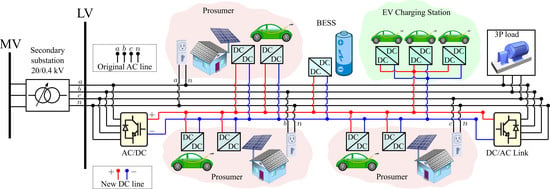Ancillary Services in Hybrid AC/DC Low Voltage Distribution Networks
Abstract
1. Introduction
2. AC LV Distribution Networks
2.1. One-Way LV Distribution Feeders
2.2. Two-Way Distribution Feeders
2.2.1. Utility-Scale Power Electronic Devices
- Solid-State Tap Changer (SSTC). The objective of this device is to regulate the voltage on the LV side by changing the turns ratio of the MV/LV transformer. This device uses a set of static switches, usually made up of two antiparallel thyristors instead of the traditional mechanical switches. These switches, installed in the MV transformer regulation winding, are always operated in on/off mode, therefore preventing the risk of introducing harmonic distortion in the system, at the cost of regulating the voltage in a stepwise manner, as shown in Figure 4a [16]. Other SSTC topologies based on IGBT technology have been proposed in the specialized literature, which are able to regulate the LV voltage in a continuous manner, at the cost of higher power losses and harmonic distortion [17]. In any case, these devices are serious competitors of the traditional on-load tap changer (OLTC) based on mechanical switches, owing to the absence of movable parts, unlimited number of maneuvers, fast voltage regulation and almost null maintenance cost.
- STATCOM. This device is based on a Voltage Source Converter (VSC) equipped with IGBTs and an isolated DC bus, as shown in Figure 4b. The aim of this device is to inject reactive power to the system to control the voltage of its point of connection [16,18,19]. In addition, it is possible to operate this device to mitigate the inherent imbalance of the LV system [20]. For this purpose, four-wire topologies are preferred so that zero-sequence components can be compensated [21,22,23,24].
- BESS. This asset is composed of a VSC with a battery for energy storage connected to the DC bus, as shown in Figure 4c [25]. The main goal of this device is to inject or absorb active power to the system to provide different ancillary services, ranging from frequency regulation [26], peak shaving [27] and energy shifting [28]. In addition, it is possible to contribute to the voltage regulation by means of active and/or reactive power injections.
- DC link. The aim of this device, also known as flexible link, is to create a controllable loop between the radial feeders to which it is connected. It is composed of two VSCs connected in back-to-back configuration sharing a common DC bus, as shown in Figure 4d [29]. This device may control the active power flow between the interconnected feeders and two independent reactive power injections. This provides an extraordinary flexibility to the distribution system operation [30,31]. In fact, this device can fully overcome the barrier related to the radial nature of the LV distribution system, because network congestions in one feeder can be alleviated using the neighbor feeder as a back-up supply point. The use of this DC link is advantageous when compared to a conventional meshed operation, where the active and reactive loop flows cannot be controlled. In addition, the meshed operation requires an expensive protection system to cope with short-circuit faults [32]. On the one hand, the short-circuit current increases as both interconnected feeders contribute to the fault current. On the other hand, note that the protections of both interconnected feeders should trip in the case of a short-circuit fault and, therefore, disconnecting a larger number of customers in comparison to the radial operation case. The use of DC links, based on back-to-back VSCSs, prevents this undesired effect, as the healthy feeder can be quickly isolated from the faulted one by just inhibiting the gating signals to the IGBTs. This way, it is possible to maintain the conventional, simple and reliable protection system used in LV radial distribution networks. It is worth noting that it is possible to interconnect N feeders by means of multi-terminal arrangements. This multi-terminal device, composed of N converters, has degrees of freedom, of them corresponding to active power flows (as one of the VSCs must control the DC bus voltage) and N to reactive power flows [33]. Finally, it is interesting to highlight that the DC bus of this device may incorporate a PV generator, a battery or even an EV fast charger station, providing even more flexibility of operation [31]. Alternative topologies have also been proposed to reduce as much as possible the rating of the power electronic components, aimed at reducing its cost [34].
2.2.2. Control Systems
- Determine, in a coordinated fashion, the control actions of the different assets spread along the distribution system to improve its operation. In this sense, the control assets may belong either to the utility or third-parties, such as PV generator or EV charger, which may provide different ancillary services. These control actions can be obtained by means of algorithms specially tailored to each specific application. Mimicking the customary structure of AC transmission control systems, those algorithms can be hierarchically organized in three control layers with different time scales. The primary control level provides fast reactions aimed at rejecting any system perturbation and maintaining the controlled variables close to their reference values. This is usually implemented locally, following a linear droop, which calls for a slower secondary control intended to eliminate the steady-state error associated to the primary control. Finally, the third and slower control layer is devoted to computing the optimal reference values for the controlled variables by introducing some optimization criteria [37].
- Interact with the Distribution Management System (DMS) of the utility: (i) to provide aggregated data of the downstream system state; and (ii) to receive control requirements to provide ancillary services to the MV network.
3. Hybrid AC/DC Networks
3.1. Network Topologies
3.2. Power Electronic Converters
3.3. Control Algorithms
4. Ancillary Services in AC and Hybrid AC/DC LV Distribution Systems
4.1. Voltage Control
4.2. Congestion Release
4.3. Unbalance Reduction
4.4. Harmonic Mitigation
4.5. Power Smoothing
4.6. Inertial Response
- Exact synchronous generators model-based methods, where the objective is to mimic the exact dynamic behavior of the electrical machine by means of a detailed mathematical model in the control algorithm of the converter interfacing the storage system. The following methods can be framed within this category: synchronverters [143,144], virtual synchronous machine [145] and KHI topology [146].
- Frequency-based response techniques. In this case, the control algorithm reacts on any frequency disturbance and, therefore, provides an inertial response on an indirect way. Virtual synchronous generators [149] have been proposed within this category.
4.7. Power Frequency Response
5. Conclusions
Author Contributions
Funding
Conflicts of Interest
Abbreviations
| AC | Alternating Current |
| AMI | Advanced Metering Infrastructure |
| BESS | Battery Energy Storage System |
| DC | Direct Current |
| DFACTS | Distribution Flexible AC Transmission System |
| EV | Electric Vehicle |
| HVDC | High voltage DC |
| ICT | Information and Communication Infrastructure |
| IEA | International Energy Agency |
| IRENA | International Renewable Energy Agency |
| LV | Low voltage |
| MV | Medium Voltage |
| PEB | Power Electronic Block |
| PV | Phtovoltaic |
References
- Willis, H.L. Power Distribution Planning Reference Book; Marcel Dekker: New York, NU, USA, 2004. [Google Scholar]
- Habib, S.; Khan, M.M.; Abbas, F.; Sang, L.; Shahid, M.U.; Tang, H. A Comprehensive Study of Implemented International Standards, Technical Challenges, Impacts and Prospects for Electric Vehicles. IEEE Access 2018, 6, 13866–13890. [Google Scholar] [CrossRef]
- Grunditz, E.A.; Thiringer, T. Performance Analysis of Current BEVs Based on a Comprehensive Review of Specifications. IEEE Trans. Transp. Electrif. 2016, 2, 270–289. [Google Scholar] [CrossRef]
- Cheng, M.; Tong, M. Development status and trend of electric vehicles in China. Chin. J. Electr. Eng. 2017, 3, 1–13. [Google Scholar]
- Burger, S.P.; Jenkins, J.D.; Huntington, S.C.; Perez-Arriaga, I.J. Why Distributed? A Critical Review of the Tradeoffs Between Centralized and Decentralized Resources. IEEE Power Energy Mang. 2019, 17, 16–24. [Google Scholar] [CrossRef]
- Blaabjerg, F.; Yang, Y.; Yang, D.; Wang, X. Distributed Power-Generation Systems and Protection. Proc. IEEE 2017, 105, 1311–1331. [Google Scholar] [CrossRef]
- Wu, Y.; Lin, J.; Lin, H. Standards and Guidelines for Grid-Connected Photovoltaic Generation Systems: A Review and Comparison. IEEE Trans. Ind. Appl. 2017, 53, 3205–3216. [Google Scholar] [CrossRef]
- Global EV Outlook 2017; International Energy Agency (IEA): Paris, France, 2017.
- REmap: Roadmap for a Renewable Energy Future; International Renewable Energy Agency (IRENA): Masdar City, Abu Dhabi, 2016.
- Boicea, V.A. Energy Storage Technologies: The Past and the Present. Proc. IEEE 2014, 102, 1777–1794. [Google Scholar] [CrossRef]
- Wang, G.; Konstantinou, G.; Townsend, C.D.; Pou, J.; Vázquez, S.; Demetriades, G.D.; Agelidis, V.G. A Review of Power Electronics for Grid Connection of Utility-Scale Battery Energy Storage Systems. IEEE Trans. Sustain. Energy 2016, 7, 1778–1790. [Google Scholar] [CrossRef]
- Chang, L.; Zhang, W.; Xu, S.; Spence, K. Review on distributed energy storage systems for utility applications. Cpss Trans. Power Electron. Appl. 2017, 2, 267–276. [Google Scholar] [CrossRef]
- Battery Electricity Storage Costs and Market Outlook to 2030; International Renewable Energy Agency (IRENA): Masdar City, Abu Dhabi, 2016.
- Gómez-Expósito, A.; Arcos-Vargas, A.; Maza-Ortega, J.M.; Rosendo-Macías, J.A.; Álvarez-Cordero, G.; Carillo-Aparicio, S.; González-Lara, J.; Morales-Wagner, D.; González-García, T. City-Friendly Smart Network Technologies and Infrastructures: The Spanish Experience. Proc. IEEE 2018, 106, 626–660. [Google Scholar]
- Markiewicz, H.; Klajn, A. EN50160, Voltage Characteristics of Electricity Supplied by Public Distribution Systems; CENELEC: Brussels, Belgium, 2011. [Google Scholar]
- Hingorani, N.G.; Gyugyi, L. Understanding FACTS: Concepts and Technology of Flexible AC Transmission Systems; Wiley-IEEE Press: New York, NY, USA, 2000. [Google Scholar]
- Bauer, P.; de Haan, S.W.H. Electronic tap changer for 500 kVA/10 kV distribution transformers: Design, experimental results and impact in distribution networks. In Proceedings of the 33rd IEEE Industry Applications Society (IAS) Conference, St. Louis, MI, USA, 12–15 October 1998; Volume 2, pp. 1530–1537. [Google Scholar]
- Acha, E.; Agelidis, V.G.; Anaya-Lara, O.; Miller, T.H.E. Power Electronic Control in Electrical Systems; Newnes Power Engineering Series; Elsevier: Oxford, UK, 2001. [Google Scholar]
- Sood, V.K. HVDC and FACTS Controllers: Applications of Static Converters in Power Systems; Springer: Boston, MA, USA, 2004. [Google Scholar]
- Ghosh, A.; Ledwich, G. Power Quality Enhancement Using Custom Power Devices; Kluwer Academic Publishers: Boston, MA, USA, 2002. [Google Scholar]
- Meersman, B.; Renders, B.; Degroote, L.; Vandoorn, T.; De Kooning, J.; Vandevelde, L. Overview of three-phase inverter topologies for distributed generation purposes. In Proceedings of the Innovation for Sustainable Production i-SUP, Bruges, Belgium, 18–21 April 2010; pp. 24–28. [Google Scholar]
- Verdelho, P.; Marques, G.D. Four-wire current-regulated PWM voltage converter. IEEE Trans. Ind. Electron. 1998, 45, 761–770. [Google Scholar] [CrossRef]
- Liang, J.; Green, T.C.; Feng, C.; Weiss, G. Increasing voltage utilization in spilt-link four-wire inverters. IEEE Trans. Power Electron. 2009, 24, 1562–1569. [Google Scholar] [CrossRef]
- Carrasco, J.M.; García Franquelo, L.; Bialasiewicz, J.T.; Galván, E.; Portillo Guisado, R.C.; Martín Prats, M.A.; León, I.; Moreno-Alfonso, N. Power-Electronic Systems for the Grid Integration of Renewable Energy Sources: A Survey. IEEE Trans. Ind. Electron. 2006, 53, 1002–1016. [Google Scholar] [CrossRef]
- Lawder, M.T.; Suthar, B.; Northrop, P.W.C.; De, S.; Hoff, C.M.; Leitermann, O.; Crow, M.L.; Santhanagopalan, S.; Subramanian, V.R. Battery Energy Storage System (BESS) and Battery Management System (BMS) for Grid-Scale Applications. Proc. IEEE 2014, 102, 1014–1030. [Google Scholar] [CrossRef]
- Oudalov, A.; Chartouni, D.; Ohler, C. Optimizing a Battery Energy Storage System for Primary Frequency Control. IEEE Trans. Power Syst. 2007, 22, 1259–1266. [Google Scholar] [CrossRef]
- Yang, Y.; Li, H.; Aichhorn, A.; Zheng, J.; Greenleaf, M. Sizing Strategy of Distributed Battery Storage System With High Penetration of Photovoltaic for Voltage Regulation and Peak Load Shaving. IEEE Trans. Smart Grid 2014, 5, 982–991. [Google Scholar] [CrossRef]
- Abdelrazek, S.A.; Kamalasadan, S. Integrated PV Capacity Firming and Energy Time Shift Battery Energy Storage Management Using Energy-Oriented Optimization. IEEE Trans. Ind. Appl. 2016, 52, 2607–2617. [Google Scholar] [CrossRef]
- Okada, N.; Takasaki, M.; Sakai, H.; Katoh, S. Development of a 6.6 kV–1 MVA Transformerless Loop Balance Controller. In Proceedings of the 2007 IEEE Power Electronics Specialists Conference, Orlando, FL, USA, 17–21 June 2007. [Google Scholar]
- Romero-Ramos, E.; Gómez-Expósito, A.; Marano, A.; Maza-Ortega, J.M.; Martínez-Ramos, J.L. Assessing the loadability of active distribution networks in the presence of DC controllable links. IET Gener. Transm. Distrib. 2011, 5, 1105–1113. [Google Scholar] [CrossRef]
- Gómez-Expósito, A.; Maza-Ortega, J.M.; Romero-Ramos, E.; Marano, A. Enhancing Integration of Renewables in Radial Distribution Networks through Smart Links in Iniewski, K; Smart Grid: Infrastructure and Networking, Ed.; McGraw-Hill: New York, NY, USA, 2012; pp. 155–179. [Google Scholar]
- Lazarou, S.; Vita, V.; Ekonomou, L. Protection Schemes of Meshed Distribution Networks for Smart Grids and Electric Vehicles. Energies 2018, 11, 3106. [Google Scholar] [CrossRef]
- García López, F.P.; Barragán-Villarejo, M.; Maza-Ortega, J.M. Grid-friendly integration of electric vehicle fast charging station based on multiterminal DC link. Int. J. Electr. Power Energy Syst. 2020, 114, 1–15. [Google Scholar] [CrossRef]
- Maza-Ortega, J.M.; Gómez-Expósito, A.; Barragán-Villarejo, M.; Romero-Ramos, E.; Marano-Marcolini, A. Voltage source converter-based topologies to further integrate renewable energy sources in distribution systems. IET Renew. Power Gener. 2012, 6, 435–445. [Google Scholar] [CrossRef]
- Tsikalakis, A.G.; Hatziargyriou, N.D. Centralized Control for Optimizing Microgrids Operation. IEEE Trans. Energy Convers. 2008, 23, 241–248. [Google Scholar] [CrossRef]
- Sun, Q.; Li, H.; Ma, Z.; Wang, C.; Campillo, J.; Zhang, Q.; Wallin, F.; Guo, J. A Comprehensive Review of Smart Energy Meters in Intelligent Energy Networks. IEEE Internet Things J. 2016, 3, 464–479. [Google Scholar] [CrossRef]
- Gómez-Expósito, A.; Conejo, A.; Canizares, A. Electric Energy Systems: Analysis and Operation; CRC Press: Boca Raton, FL, USA, 2008. [Google Scholar]
- Bose, A. Smart transmission grid applications and their supporting infrastructure. IEEE Trans. Smart Grid 2010, 1, 11–19. [Google Scholar] [CrossRef]
- Wang, Y.; Yemula, P.; Bose, A. Decentralized communication and control systems for power system operation. IEEE Trans. Smart Grid 2015, 6, 885–893. [Google Scholar] [CrossRef]
- Cassel, W.R. Distribution management systems: Functions and payback. IEEE Trans. Power Syst. 1993, 8, 796–801. [Google Scholar] [CrossRef]
- Long, W.; Nilsson, S. HVDC transmission: yesterday and today. IEEE Power Energy Mag. 2007, 5, 22–31. [Google Scholar] [CrossRef]
- Flourentzou, N.; Agelidis, V.G.; Demetriades, G.D. VSC-Based HVDC Power Transmission Systems: An Overview. IEEE Trans. Power Electron. 2009, 24, 592–602. [Google Scholar] [CrossRef]
- Lundberg, P.; Gustafsson, A.; Jeroense, M. Recent advancements in HVDC systems. HVDC and power electronics technology and development. In Proceedings of the 2015 CIGRE, Paris, France, 26–31 August 2015. [Google Scholar]
- Sellick, R.L.; Akerberg, M. Comparison of HVDC Light (VSC) and HVDC Classis (LCC) site aspects, for a 500 MW 400 kV HVDC transmission scheme. In Proceedings of the 2012 IET AC/DC Conference, Birmingham, UK, 4–5 December 2012. [Google Scholar]
- Oni, O.E.; Davidson, I.E.; Mbangula, K.N.I. A review of LCC-HVDC and VSC-HVDC technologies and applications. In Proceedings of the 2016 IEEE 16th International Conference on Environment and Electrical Engineering (EEEIC), Florence, Italy, 7–10 June 2016. [Google Scholar]
- Lin, W.; Jovcic, D.; Yao, L.; Sun, W.; Lu, X.; Wen, J. Investigation of interconnecting two Chinese LCC-HVDC through LCL DC/DC converter. In Proceedings of the 2015 IEEE PES Asia-Pacific Power and Energy Engineering Conference (APPEEC), Brisbane, Australia, 15 November 2015. [Google Scholar]
- Korompili, A.; Wu, Q.; Zhao, H. Review of VSC HVDC connection for offshore wind power integration. Renew. Sust. Energy Rev. 2016, 59, 1405–1414. [Google Scholar] [CrossRef]
- Bresesti, P.; Kling, W.L.; Hendriks, R.L.; Vailati, R. HVDC Connection of Offshore Wind Farms to the Transmission System. IEEE Trans. Energy Convers. 2007, 22, 37–43. [Google Scholar] [CrossRef]
- Lasseter, R. White Paper on Integration of Distributed Energy Resources—The CERTS MicroGrid Concept; Technical Report; California Energy Commission: Berkeley, CA, USA, 2002. [Google Scholar]
- Dragicevic, T.; Lu, X.; Vasquez, J.C.; Guerrero, J.M. DC Microgrid - Part II: A Review of Power Architectures, Applications, and Standardization Issues. IEEE Trans. Power Electron. 2016, 31, 3528–3549. [Google Scholar] [CrossRef]
- Zubieta, L.E. Are Microgrids the Future of Energy?: DC Microgrids from Concept to Demonstration to Deployment. IEEE Electrif. Mag. 2016, 4, 37–44. [Google Scholar] [CrossRef]
- Elsayed, A.T.; Mohamed, A.A.; Mohammed, O.A. DC microgrids and distribution systems: An overview. Electr. Power Syst. Res. 2015, 119, 407–417. [Google Scholar] [CrossRef]
- Justo, J.J.; Mwasilu, F.; Lee, J.; Jung, J.W. AC-microgrids versus DC-microgrids with distributed energy resources: A review. Renew. Sustain. Energy Rev. 2013, 24, 387–405. [Google Scholar] [CrossRef]
- Wang, P.; Goel, L.; Liu, X.; Choo, F.H. Harmonizing AC and DC: A Hybrid AC/DC Future Grid Solution. IEEE Power Energy Mag. 2013, 11, 76–83. [Google Scholar] [CrossRef]
- Majumder, R. A hybrid microgrid with dc connection at back to back converters. IEEE Trans. Smart Grid 2014, 5, 251–259. [Google Scholar] [CrossRef]
- Kakigano, H.; Miura, Y.; Ise, T. Low-voltage bipolar-type dc microgrid for super high quality distribution. IEEE Trans. Power Electron. 2010, 25, 3066–3075. [Google Scholar] [CrossRef]
- Huang, A.Q.; Crow, M.L.; Heydt, G.T.; Zheng, J.P.; Dale, S.J. The Future Renewable Electric Energy Delivery and Management (FREEDM) System: The Energy Internet. Proc. IEEE 2010, 99, 133–148. [Google Scholar] [CrossRef]
- Boroyevich, D.; Cvetkovic, I.; Burgos, R.; Dong, D. Intergrid: A Future Electronic Energy Network? IEEE J. Emer. Sel. Top. Power Electron. 2013, 1, 127–138. [Google Scholar] [CrossRef]
- Unamuno, E.; Barrena, J.A. Hybrid ac/dc microgrids–Part I: Review and classification of topologies. Renew. Sustain. Energy Rev. 2015, 52, 1251–1259. [Google Scholar] [CrossRef]
- Antoniou, D.; Tzimas, A.; Rowland, S.M. Transition from alternating current to direct current low voltage distribution networks. IET Gener. Transm. Distrib. 2015, 9, 1391–1401. [Google Scholar] [CrossRef]
- Wu, T.F.; Kuo, C.L.; Lin, L.C.; Chen, Y.K. DC-Bus Voltage Regulation for a DC Distribution System With a Single-Phase Bidirectional Inverter. IEEE J. Emerg. Sel. Top. Power Electron. 2016, 4, 210–220. [Google Scholar] [CrossRef]
- Dong, D.; Cvetkovic, I.; Boroyevich, I.; Zhang, W.; Wang, R.; Mattavelli, P. Grid-interface bidirectional converter for residential DC distribution systems—Part one: High-density two-stage topology. IEEE Trans. Power Electron. 2013, 28, 1655–1666. [Google Scholar] [CrossRef]
- Dong, D.; Luo, F.; Zhang, X.; Boroyevich, D.; Mattavelli, P. Grid-interface bidirectional converter for residential DC distribution systems—Part 2: AC and DC interface design with passive components minimization. IEEE Trans. Power Electron. 2013, 28, 1667–1679. [Google Scholar] [CrossRef]
- Tofoli, F.L.; Pereira, D.C.; Josias de Paula, W.; Oliveira Júnior, D.S. Survey on non-isolated high-voltage step-up dc-dc topologies based on the boost converter. IET Power Electron. 2015, 8, 2044–2057. [Google Scholar] [CrossRef]
- Rehman, Z.; Al-Bahadly, I.; Mukhopadhyay, S. Multi-input DC-DC converters in renewable energy applications—An overview. Renew. Sustain. Energy Rev. 2015, 41, 521–539. [Google Scholar] [CrossRef]
- Inoue, S.; Akagi, H. A Bidirectional DC-DC Converter for an Energy Storage System With Galvanic Isolation. IEEE Trans. Power Electron. 2007, 22, 2299–2306. [Google Scholar] [CrossRef]
- Shaaban, M.F.; Eajal, A.A. Coordinated charging of plug-in hybrid electric vehicles in smart hybrid AC/DC distribution systems. Renew. Energy 2015, 82, 92–99. [Google Scholar] [CrossRef]
- Mohamed, A.; Mohammed, O. Real-time energy management scheme for hybrid renewable energy systems in smart grid applications. Electr. Power Syst. Res. 2013, 96, 133–143. [Google Scholar] [CrossRef]
- Eajal, A.A.; Member, S.; Shaaban, M.F.; Member, S. Stochastic Centralized Dispatch scheme for Hybrid AC/DC Smart Distribution Systems. IEEE Trans. Sustain. Energy 2016, 7, 1046–1059. [Google Scholar] [CrossRef]
- Keles, C.; Karabiber, A.; Akcin, M.; Kaygusuz, A.; Baykant Alagoz, B.; Gul, O. A smart building power management concept: Smart socket applications with DC distribution. Int. J. Electr. Power Energy Syst. 2015, 64, 679–688. [Google Scholar] [CrossRef]
- Unamuno, E.; Barrena, J.A. Hybrid ac/dc microgrids - Part II: Review and classification of control strategies. Renew. Sustain. Energy Rev. 2015, 52, 1123–1134. [Google Scholar] [CrossRef]
- Lopes, J.A.P.; Moreira, C.L.; Madureira, A.G. Defining control strategies for MicroGrids islanded operation. IEEE Trans. Power Syst. 2006, 21, 916–924. [Google Scholar] [CrossRef]
- Chai, R.; Zhang, B.; Dou, J.; Hao, Z.; Zheng, T. Unified Power Flow Algorithm Based on the NR Method for Hybrid AC/DC Grids Incorporating VSCs. IEEE Trans. Power Syst. 2016, 31, 4310–4318. [Google Scholar] [CrossRef]
- Eajal, A.A.; Abdelwahed, M.A.; El-Saadany, E.F.; Ponnambalam, K. A Unified Approach to the Power Flow Analysis of AC/DC Hybrid Microgrids. IEEE Trans. Sust. Ener. 2016, 7, 1145–1158. [Google Scholar] [CrossRef]
- Hamad, A.A.; Azzouz, M.A.; El Saadany, E.F. A Sequential Power Flow Algorithm for Islanded Hybrid AC/DC Microgrids. IEEE Trans. Power Syst. 2016, 31, 3961–3970. [Google Scholar] [CrossRef]
- Abur, A.; Gómez-Expósito, A. Power System State Estimation: Theory and Implementation; Marcel Dekker: New York, NY, USA, 2004. [Google Scholar]
- Villa-Jaén, A.; Acha, E.; Gómez-Expósito, A. Voltage Source Converter Modeling for Power System State Estimation: STATCOM and VSC-HVDC. IEEE Trans. Power Syst. 2008, 23, 1552–1559. [Google Scholar] [CrossRef]
- Donde, V.; Feng, X.; Segerqvist, I.; Callavik, M. Distributed State Estimation of Hybrid AC/HVDC Grids by Network Decomposition. IEEE Trans. Smart Grid 2016, 7, 974–981. [Google Scholar] [CrossRef]
- Zamora-Cárdenas, E.A.; Fuerte-Esquivel, C.R.; Pizano-Martinez, A.; Estrada-García, H.J. Hybrid state estimator considering SCADA and synchronized phasor measurements in VSC-HVDC transmission links. Electr. Power Syst. Res. 2016, 133, 42–50. [Google Scholar] [CrossRef]
- Elsen, R. Ancillary Services Unbundling Electricity Products—An Emerging Market; Eurelectric: Brussels, Belgium, 2004. [Google Scholar]
- Survey on Ancillary Service Procurement, Balancing Market Design 2017; ENTSO-E: Brussels, Belgium, 2018.
- Karimi, M.; Mokhlis, H.; Naidu, K.; Uddin, S.; Bakar, A.H.A. Photovoltaic penetration issues and impacts in distribution network—A review. Renew. Sustain. Energy Rev. 2016, 53, 594–605. [Google Scholar] [CrossRef]
- Stetz, T.; Marten, F.; Braun, M. Improved Low Voltage Grid-Integration of Photovoltaic Systems in Germany. IEEE Trans. Sustain. Energy 2013, 4, 534–542. [Google Scholar] [CrossRef]
- Chalise, S.; Atia, H.R.; Poudel, B.; Tonkoski, R. Impact of Active Power Curtailment of Wind Turbines Connected to Residential Feeders for Overvoltage Prevention. IEEE Trans. Sustain. Energy 2016, 7, 471–479. [Google Scholar] [CrossRef]
- Farag, H.E.; El-Saadany, E.F.; Seethapathy, R. A Two Ways Communication-Based Distributed Control for Voltage Regulation in Smart Distribution Feeders. IEEE Trans. Smart Grid 2012, 3, 271–281. [Google Scholar] [CrossRef]
- Robbins, B.A.; Hadjicostis, C.N.; Domínguez-García, A.D. A Two-Stage Distributed Architecture for Voltage Control in Power Distribution Systems. IEEE Trans. Power Syst. 2013, 28, 1470–1482. [Google Scholar] [CrossRef]
- Yeh, H.; Gayme, D.F.; Low, S.H. Adaptive VAR Control for Distribution Circuits With Photovoltaic Generators. IEEE Trans. Power Syst. 2012, 27, 1656–1663. [Google Scholar] [CrossRef]
- Yong, J.Y.; Ramachandaramurthy, V.K.; Tan, K.M.; Mithulananthan, N. Bi-directional electric vehicle fast charging station with novel reactive power compensation for voltage regulation. Int. J. Electr. Power Energy Syst. 2015, 64, 300–310. [Google Scholar] [CrossRef]
- Demirok, E.; González, P.C.; Frederiksen, K.H.B.; Sera, D.; Rodriguez, P.; Teodorescu, R. Local Reactive Power Control Methods for Overvoltage Prevention of Distributed Solar Inverters in Low-Voltage Grids. IEEE J. Photovoltaics 2011, 1, 174–182. [Google Scholar] [CrossRef]
- Calderaro, V.; Galdi, V.; Lamberti, F.; Piccolo, A. A Smart Strategy for Voltage Control Ancillary Service in Distribution Networks. IEEE Trans. Power Syst. 2015, 30, 494–502. [Google Scholar] [CrossRef]
- Wang, L.; Bai, F.; Yan, R.; Saha, T.K. Real-Time Coordinated Voltage Control of PV Inverters and Energy Storage for Weak Networks With High PV Penetration. IEEE Trans. Power Syst. 2018, 33, 3383–3395. [Google Scholar] [CrossRef]
- Monroy, D.; Gómez-Expósito, A.; Romero-Ramos, E. Improving the voltage regulation of secondary feeders by applying solid-state tap changers to MV/LV transformers. In Proceedings of the 9th International Conference on Electrical Power Quality and Utilisation, Barcelona, Spain, 9–11 October 2007; pp. 1–6. [Google Scholar]
- Marano-Marcolini, A.; Maza-Ortega, J.M.; Martínez-Ramos, J.L.; Trebolle, D. Voltage control of active distribution networks by means of dispersed generation. In Proceedings of the CIRED Workshop 2012 Lisboa, Lisbon, Portugal, 29–30 May 2012. [Google Scholar]
- García-López, F.P.; Barragán-Villarejo, M.; Marano-Marcolini, A.; Maza-Ortega, J.M.; Martínez-Ramos, J.L. Experimental Assessment of a Centralised Controller for High-RES Active Distribution Networks. Energies 2018, 11, 3364. [Google Scholar] [CrossRef]
- Prabhala, V.A.; Baddipadiga, B.P.; Fajri, P.; Ferdowsi, M. An Overview of Direct Current Distribution System Architectures & Benefits. Energies 2018, 11, 2463–2483. [Google Scholar]
- Marchionini, B. Direct Current In Buildings; Technical Report; NEMA: Rosslyn, VA, USA, 2018. [Google Scholar]
- Reed, G.F.; Grainger, B.M.; Sparacino, A.R.; Mao, Z. Ship to Grid: Medium-Voltage DC Concepts in Theory and Practice. IEEE Power Energy Mag. 2012, 10, 70–79. [Google Scholar] [CrossRef]
- Jin, C.; Wang, P.; Xiao, J.; Tang, Y.; Choo, F.H. Implementation of Hierarchical Control in DC Microgrids. IEEE Trans. Ind. Electron. 2014, 61, 4032–4042. [Google Scholar] [CrossRef]
- Liu, X.; Wang, P.; Loh, P.C. A Hybrid AC/DC Microgrid and Its Coordination Control. IEEE Trans. Smart Grid 2011, 2, 278–286. [Google Scholar]
- Walling, R.A.; Saint, R.; Dugan, R.C.; Burke, J.; Kojovic, L.A. Summary of Distributed Resources Impact on Power Delivery Systems. IEEE Trans. Power Deliv. 2008, 23, 1636–1644. [Google Scholar] [CrossRef]
- Assessing the Impact of Low Carbon Technologies on Great Britain’s Power Distribution Networks; Technical Report; Office of Gas and Electricity Markets: London, UK, 2012.
- Bahramipanah, M.; Torregrossa, D.; Cherkaoui, R.; Paolone, M. A Decentralized Adaptive Model-Based Real-Time Control for Active Distribution Networks Using Battery Energy Storage Systems. IEEE Trans. Smart Grid 2018, 9, 3406–3418. [Google Scholar] [CrossRef]
- Ueda, Y.; Kurokawa, K.; Tanabe, T.; Kitamura, K.; Sugihara, H. Analysis Results of Output Power Loss Due to the Grid Voltage Rise in Grid-Connected Photovoltaic Power Generation Systems. IEEE Trans. Ind. Electron. 2008, 55, 2744–2751. [Google Scholar] [CrossRef]
- Molina-García, A.; Mastromauro, R.A.; García-Sánchez, T.; Pugliese, S.; Liserre, M.; Stasi, S. Reactive Power Flow Control for PV Inverters Voltage Support in LV Distribution Networks. IEEE Trans. Smart Grid 2017, 8, 447–456. [Google Scholar] [CrossRef]
- Karagiannopoulos, S.; Aristidou, P.; Hug, G. Hybrid approach for planning and operating active distribution grids. IET Gener. Transm. Distrib. 2017, 11, 685–695. [Google Scholar] [CrossRef]
- Arias, N.B.; Franco, J.F.; Lavorato, M.; Romero, R. Metaheuristic optimization algorithms for the optimal coordination of plug-in electric vehicle charging in distribution systems with distributed generation. Electr. Power Syst. Res. 2017, 142, 351–361. [Google Scholar] [CrossRef]
- Shi, Y.; Tuan, H.D.; Savkin, A.V.; Duong, T.Q.; Poor, H.V. Model predictive control for smart grids with multiple electric-vehicle charging stations. IEEE Trans. Smart Grid 2019, 10, 2127–2136. [Google Scholar] [CrossRef]
- Lee, W.; Xiang, L.; Schober, R.; Wong, V.W.S. Electric vehicle charging stations with renewable power generators: A game theoretical analysis. IEEE Trans. Smart Grid 2015, 6, 608–617. [Google Scholar] [CrossRef]
- Ashique, R.H.; Salam, Z.; Bin Abdul Aziz, M.J.; Bhatti, A.R. Integrated photovoltaic-grid dc fast charging system for electric vehicle: A review of the architecture and control. Renew. Sustain. Energy Rev. 2017, 69, 1243–1257. [Google Scholar] [CrossRef]
- Short, T.A. Electric Power Distribution Handbook; CRC Press: Boca Raton, FL, USA, 2004. [Google Scholar]
- Beharrysingh, S. Phase Unbalance on Low-Voltage Electricity Networks and Its Mitigation Using Static Balancers. Ph.D. Thesis, Loughborough University, Leicestershire, UK, March 2014. [Google Scholar]
- IEC/TR 61000-3-14: 2011 Electromagnetic compatibility (EMC)—Part 3–14: Assessment of Emission Limits for Harmonics, Interharmonics, Voltage Fluctuations and Unbalance for the Connection of Disturbing Installations to LV Power Systems; Technical Report for International Electrotechnical Commission: Geneva, Switzerland, October 2011.
- Meersman, B.; Renders, B.; Degroote, L.; Vandoorn, T.; Vandevelde, L. Three-phase inverter-connected DG-units and voltage unbalance. Electr. Power Syst. Res. 2011, 81, 899–906. [Google Scholar] [CrossRef]
- Geth, F.; Tant, J.; Belmans, R.; Driesen, J. Balanced and unbalanced inverter strategies in battery storage systems for low-voltage grid support. IET Gener. Transm. Distrib. 2015, 9, 929–936. [Google Scholar] [CrossRef]
- Weckx, S.; Driesden, J. Load Balancing with EV Chargers and PV Inverters in Unbalanced Distribution Grids. IEEE Trans. Sustain. Energy 2015, 6, 635–643. [Google Scholar] [CrossRef]
- Coppo, M.; Turri, R.; Marinelli, M.; Han, X. Voltage management in unbalanced low voltage networks using a decoupled phase-tap-changer transformer. In Proceedings of the 49th International Universities Power Engineering Conference (UPEC), Cluj-Napoca, Romania, 2– 5 September 2014; pp. 1–6. [Google Scholar]
- Zecchino, A.; Marinelli, M.; Hu, J.; Coppo, M.; Turri, R. Voltage control for unbalanced low voltage grids using a decoupled-phase on-load tap-changer transformer and photovoltaic inverters. In Proceedings of the 50th International Universities Power Engineering Conference (UPEC), Stoke on Trent, UK, 1–4 September 2015; pp. 1–6. [Google Scholar]
- Dugan, R.; McGranaghan, M.; Santoso, S.; Beaty, H. Electrical Power System Quality; McGraw-Hill: New York, NY, USA, 2004. [Google Scholar]
- IEEE Std 519-2014 IEEE Recommended Practices and Requirements for Harmonic Control in Electrical Power Systems. Available online: https://ieeexplore.ieee.org/document/6826459 (accessed on 1 September 2019).
- Maza-Ortega, J.M.; Burgos-Payán, M.; Izquierdo-Mitchell, C. A new design method of passive tuned filters for harmonic mitigation and reactive power compensation. Eur. Trans. Electr. Power 2006, 16, 219–233. [Google Scholar] [CrossRef]
- Maza-Ortega, J.M.; Acha, E.; García, S.; Gómez-Expósito, A. Overview of power electronics technology and applications in power generation transmission and distribution. J. Mod. Power Syst. Clean Energy 2017, 5, 499–514. [Google Scholar] [CrossRef]
- Akagi, H. Active harmonic filters. Proc. IEEE 2005, 93, 2128–2141. [Google Scholar] [CrossRef]
- Akagi, H.; Watanabe, E.H.; Aredes, M. Instantaneous Power Theory and Applications to Power Conditioning; John Wiley & Sons: Hoboken, NJ, USA, 2007. [Google Scholar]
- Liang, X.; Andalib -Bin- Karim, C. Harmonics and Mitigation Techniques Through Advanced Control in Grid-Connected Renewable Energy Sources: A Review. IEEE Trans. Ind. Appl. 2018, 54, 3100–3111. [Google Scholar] [CrossRef]
- Wada, K.; Fujita, H.; Akagi, H. Considerations of a shunt active filter based on voltage detection for installation on a long distribution feeder. IEEE Trans. Ind. Appl. 2002, 38, 1123–1130. [Google Scholar] [CrossRef]
- Blanco, C.; Reigosa, D.; Vasquez, J.C.; Guerrero, J.M.; Briz, F. Virtual Admittance Loop for Voltage Harmonic Compensation in Microgrids. IEEE Trans. Ind. Appl. 2016, 52, 3348–3356. [Google Scholar] [CrossRef]
- Wu, D.; Tang, F.; Dragicevic, T.; Vasquez, J.C.; Guerrero, J.M. A Control Architecture to Coordinate Renewable Energy Sources and Energy Storage Systems in Islanded Microgrids. IEEE Trans. Smart Grid 2015, 6, 1156–1166. [Google Scholar] [CrossRef]
- Pogaku, N.; Green, T.C. Harmonic mitigation throughout a distribution system: A distributed-generator-based solution. IEE Proc. Gener. Transm. Distrib. 2006, 153, 350–358. [Google Scholar] [CrossRef]
- IEEE Std 1124-2003, Guide for the Analysis and Definition of DC-Side Harmonic Performance of HVDC Transmission Systems; IEEE: Piscataway, NJ, USA, 2003.
- Xinyu, Z.; Lei, D. A smooth scheme of wind power generation based on wind power prediction. In Proceedings of the 2011 International Conference on Transportation, Mechanical, and Electrical Engineering (TMEE), Changchun, China, 16–18 December 2011; pp. 958–961. [Google Scholar]
- Gevorgian, V.; Booth, S. Review of PREPA Technical Requirements for Interconnecting Wind and Solar Generation; Technical Report, NREL/TP-5D00-57089; NREL: Denver, CO, USA, 2013. Available online: http://www.nrel.gov/docs/fy14osti/57089.pdf (accessed on 1 September 2019).
- Bomer, J.; Burges, K.; Nabe, C.; Poller, M. All Island TSO Facilitation of Renewables Studies; Technical Report; EirGrid Plc: Dublin, Ireland, 2010; Available online: http://www.ecofys.com/en/publication/all-island-tso-facilitation-of-renewables-studies/ (accessed on 1 September 2019).
- Enslin, J.H.R. Integration of Photovoltaic Solar Power—The Quest towards Dispatchability. IEEE Instrum. Meas. Mag. 2014, 17, 21–26. [Google Scholar] [CrossRef]
- Howlader, A.M.; Urasaki, N.; Yona, A.; Senjyu, T.; Saber, A.Y. A review of output power smoothing methods for wind energy conversion systems. Renew. Sustain. Energy Rev. 2013, 26, 135–146. [Google Scholar] [CrossRef]
- Sato, D.; Saitoh, H. Smoothing Control of Wind Farm Output by Using Kinetic Energy of Variable Speed Wind Power Generators. IEEJ Trans. Power Energy 2009, 129, 580–590. [Google Scholar] [CrossRef]
- Sakamoto, R.; Senjyu, T.; Kaneko, T.; Urasaki, N.; Takagi, T.; Sugimoto, S. Output power levelling of wind turbine generator by pitch angle controller using H-infinity control. Electr. Eng. Jpn. 2008, 162, 45–57. [Google Scholar] [CrossRef]
- Dimitra Tragianni, S.; Oureilidis, K.O.; Demoulias, C.S. Supercapacitor sizing based on comparative study of PV power smoothing methods. In Proceedings of the 52nd International Universities Power Engineering Conference (UPEC), Heraklion, Greece, 28–31 August 2017; pp. 1–6. [Google Scholar]
- Li, X.; Hui, D.; Lai, X. Battery Energy Storage Station (BESS)-Based Smoothing Control of Photovoltaic (PV) and Wind Power Generation Fluctuations. IEEE Trans. Sustain. Energy 2013, 4, 464–473. [Google Scholar] [CrossRef]
- Ellis, A.; Schoenwald, D.; Hawkins, J.; Willard, S.; Arellano, B. PV output smoothing with energy storage. In Proceedings of the 2012 38th IEEE Photovoltaic Specialists Conference, Austin, TX, USA, 3–8 June 2012; pp. 1523–1528. [Google Scholar]
- Marcos, J.; Storkél, O.; Marroyo, L.; Garcia, M.; Lorenzo, E. Storage requirements for PV power ramp-rate control. Sol. Energy 2014, 99, 28–35. [Google Scholar] [CrossRef]
- Aswani, D.; Clarke-Johnson, R.; Runyan, G. The Impact of Hydroelectric Power and Other Forms of Generation on Grid Frequency Stability for The WECC Region; Technical Report; American Governor Company: Ivyland, PA, USA, 2011. [Google Scholar]
- Tamrakar, U.; Shrestha, D.; Maharjan, M.; Bhattarai, B.; Hansen, T.; Tonkoski, R. Virtual Inertia: Current Trends and Future Directions. Appl. Sci. 2017, 7, 654. [Google Scholar] [CrossRef]
- Zhong, Q.; Weiss, G. Synchronverters: Inverters That Mimic Synchronous Generators. IEEE Trans. Ind. Electron. 2011, 58, 1259–1267. [Google Scholar] [CrossRef]
- Zhong, Q.; Nguyen, P.; Ma, Z.; Sheng, W. Self-Synchronized Synchronverters: Inverters Without a Dedicated Synchronization Unit. IEEE Trans. Power Electron. 2014, 29, 617–630. [Google Scholar] [CrossRef]
- Turschner, D.; Hesse, R.; Beck, H. Virtual Synchronous Machine. In Proceedings of the 9th International Conference Electrical Power Quality and Utilisation, Barcelona, Spain, 9–11 October 2007. [Google Scholar]
- Bevrani, H.; Ise, T.; Miura, Y. Virtual synchronous generators: A survey and new perspectives. Int. J. Electr. Power Energy Syst. 2014, 54, 244–254. [Google Scholar] [CrossRef]
- Sakimoto, K.; Miura, Y.; Ise, T. Stabilization of a power system with a distributed generator by a Virtual Synchronous Generator function. In Proceedings of the 8th International Conference on Power Electronics—ECCE Asia, Jeju, Korea, 30 May–3 June 2011; pp. 1498–1505. [Google Scholar]
- Zhang, W.; Cantarellas, A.M.; Rocabert, J.; Luna, A.; Rodriguez, P. Synchronous Power Controller With Flexible Droop Characteristics for Renewable Power Generation Systems. IEEE Trans. Sustain. Energy 2016, 7, 1572–1582. [Google Scholar] [CrossRef]
- Karapanos, V.; de Haan, S.; Zwetsloot, K. Real time simulation of a power system with VSG hardware in the loop. In Proceedings of the 37th Annual Conference of the IEEE Industrial Electronics Society (IECON), Melbourne, VIC, Australia, 7–10 November 2011. [Google Scholar]
- Greenwood, D.M.; Lim, K.Y.; Patsios, C.; Lyons, P.F.; Lim, Y.S.; Taylor, P.C. Frequency response services designed for energy storage. Appl. Energy 2017, 203, 115–127. [Google Scholar] [CrossRef]
- Thorbergsson, E.; Knap, V.; Swierczynski, M.; Stroe, D.; Teodorescu, R. Primary Frequency Regulation with Li-Ion Battery Based Energy Storage System—Evaluation and Comparison of Different Control Strategies. In Proceedings of the 35th International Telecommunications Energy Conference, Smart Power and Efficiency, Hamburg, Germany, 13–17 October 2013. [Google Scholar]
- Guerrero, J.M.; Vasquez, J.C.; Matas, J.; de Vicuna, L.G.; Castilla, M. Hierarchical Control of Droop-Controlled AC and DC Microgrids—A General Approach Toward Standardization. IEEE Trans. Ind. Electron. 2011, 58, 158–172. [Google Scholar] [CrossRef]
- Stroe, D.; Knap, V.; Swierczynski, M.; Stroe, A.; Teodorescu, R. Suggested operation of grid-connected lithium-ion battery energy storage system for primary frequency regulation: Lifetime perspective. In Proceedings of the 2015 IEEE Energy Conversion Congress and Exposition (ECCE), Montreal, QC, Canada, 20–24 September 2015. [Google Scholar]
- Sharma, S.K.; Chandra, A.; Saad, M.; Lefebvre, S.; Asber, D.; Lenoir, L. Voltage Flicker Mitigation Employing Smart Loads With High Penetration of Renewable Energy in Distribution Systems. IEEE Trans. Sustain. Energy 2017, 8, 414–424. [Google Scholar] [CrossRef]
- Pourbeik, P.; Soni, S.; Gaikwad, A.; Chadliev, V. Providing Primary Frequency Response from Photovoltaic Power Plants. In Proceedings of the 2017 CIGRE Symposium, Dublin, Ireland, 29 May–2 June 2017. [Google Scholar]
- Lyu, X.; Xu, Z.; Zhao, J. A coordinated frequency control strategy for photovoltaic system in microgrid. J. Int. Counc. Electr. Eng. 2018, 8, 37–43. [Google Scholar] [CrossRef]
- Wu, Z.; Gao, W.; Gao, T. State-of-the-art review on frequency response of wind power plants in power systems. J. Mod. Power Syst. Clean Energy 2018, 6, 1–16. [Google Scholar] [CrossRef]
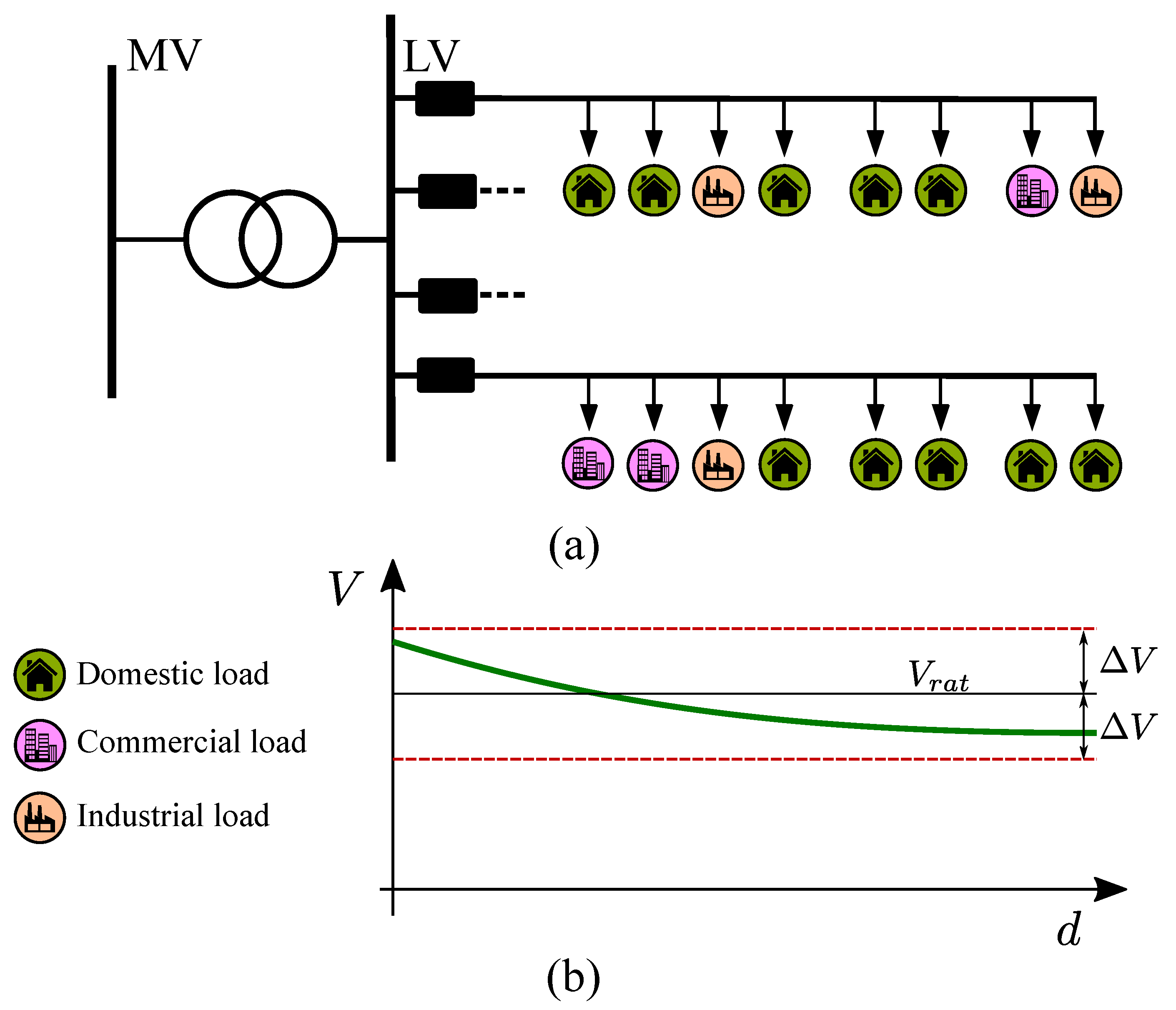
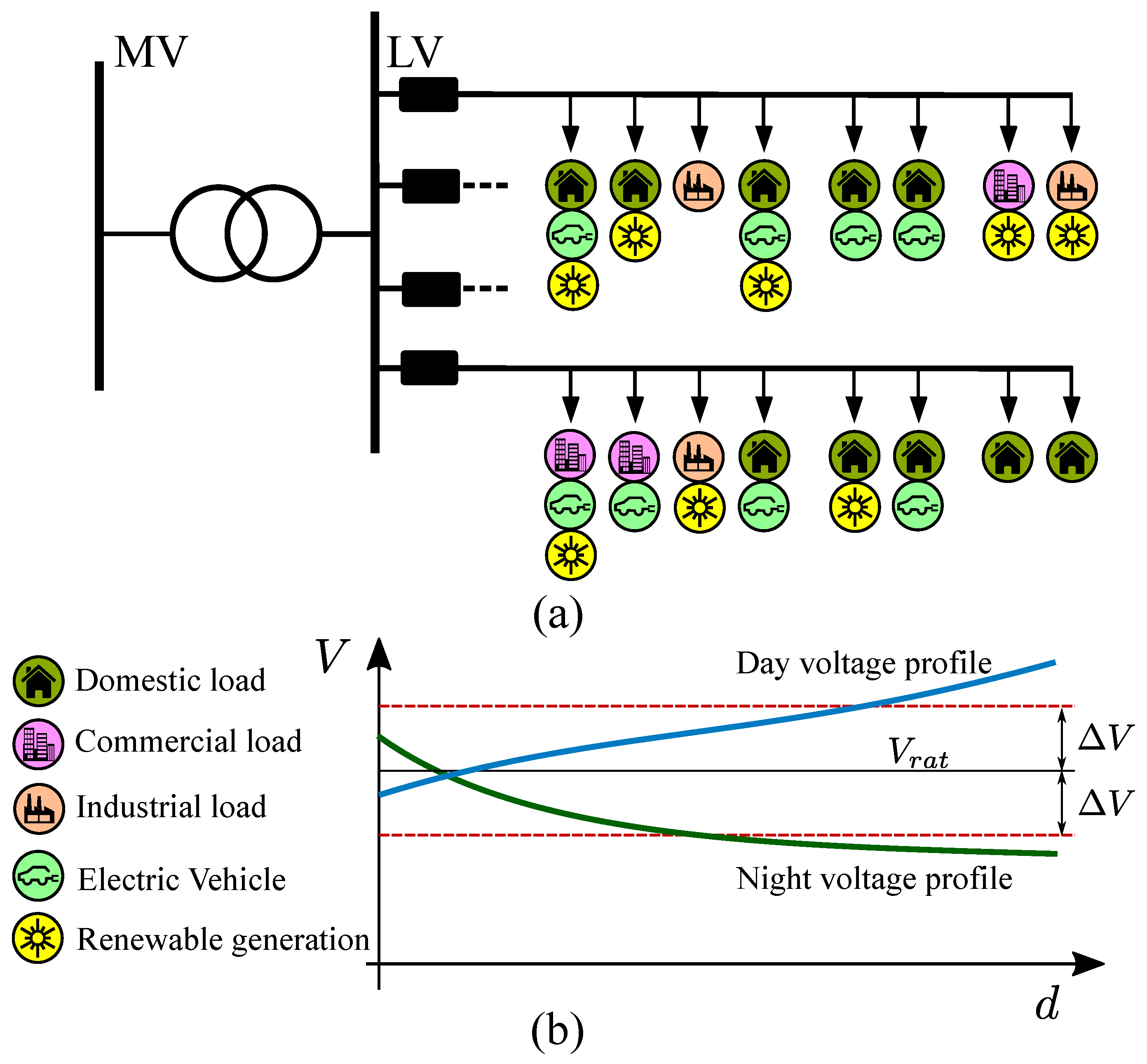
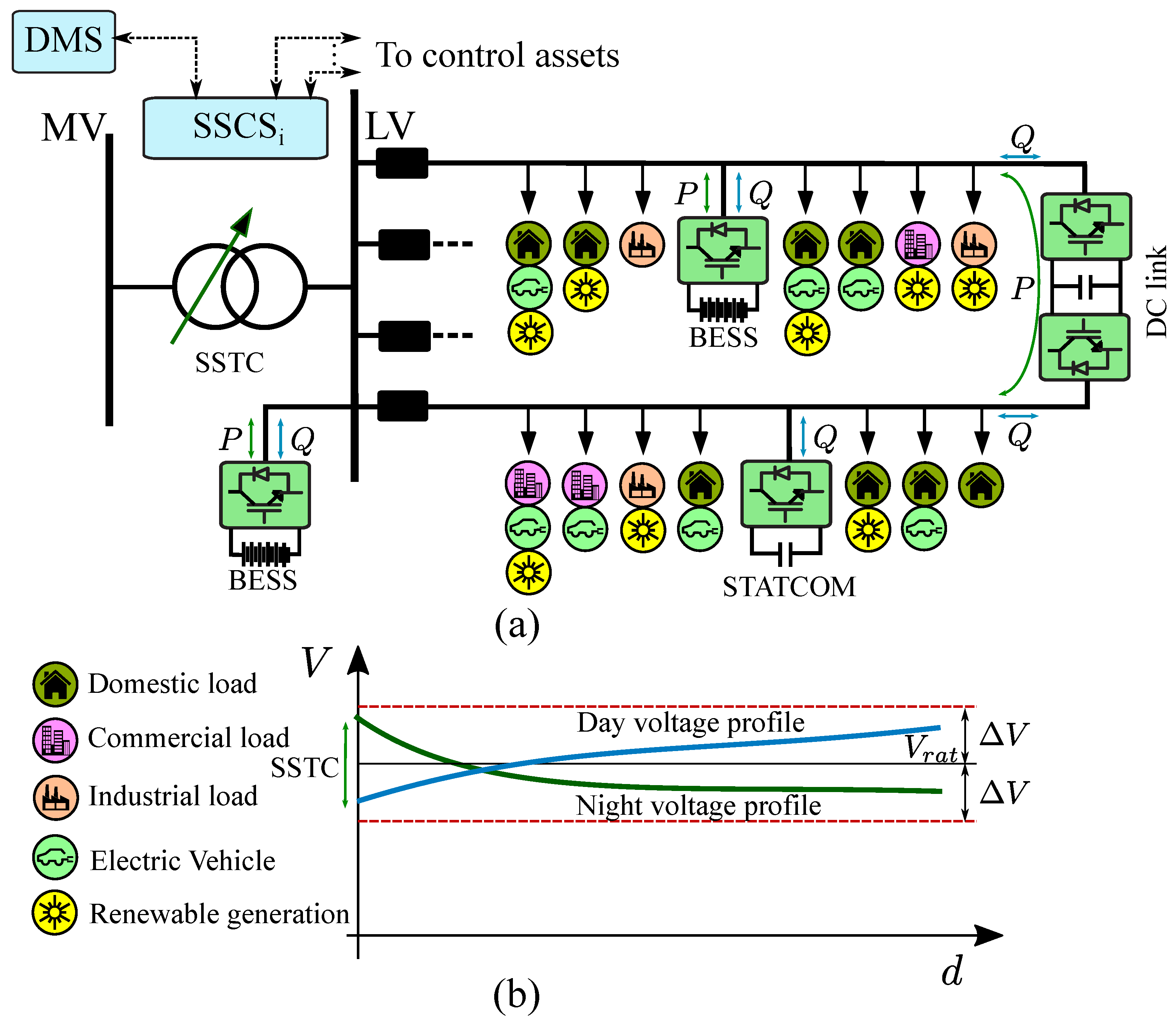
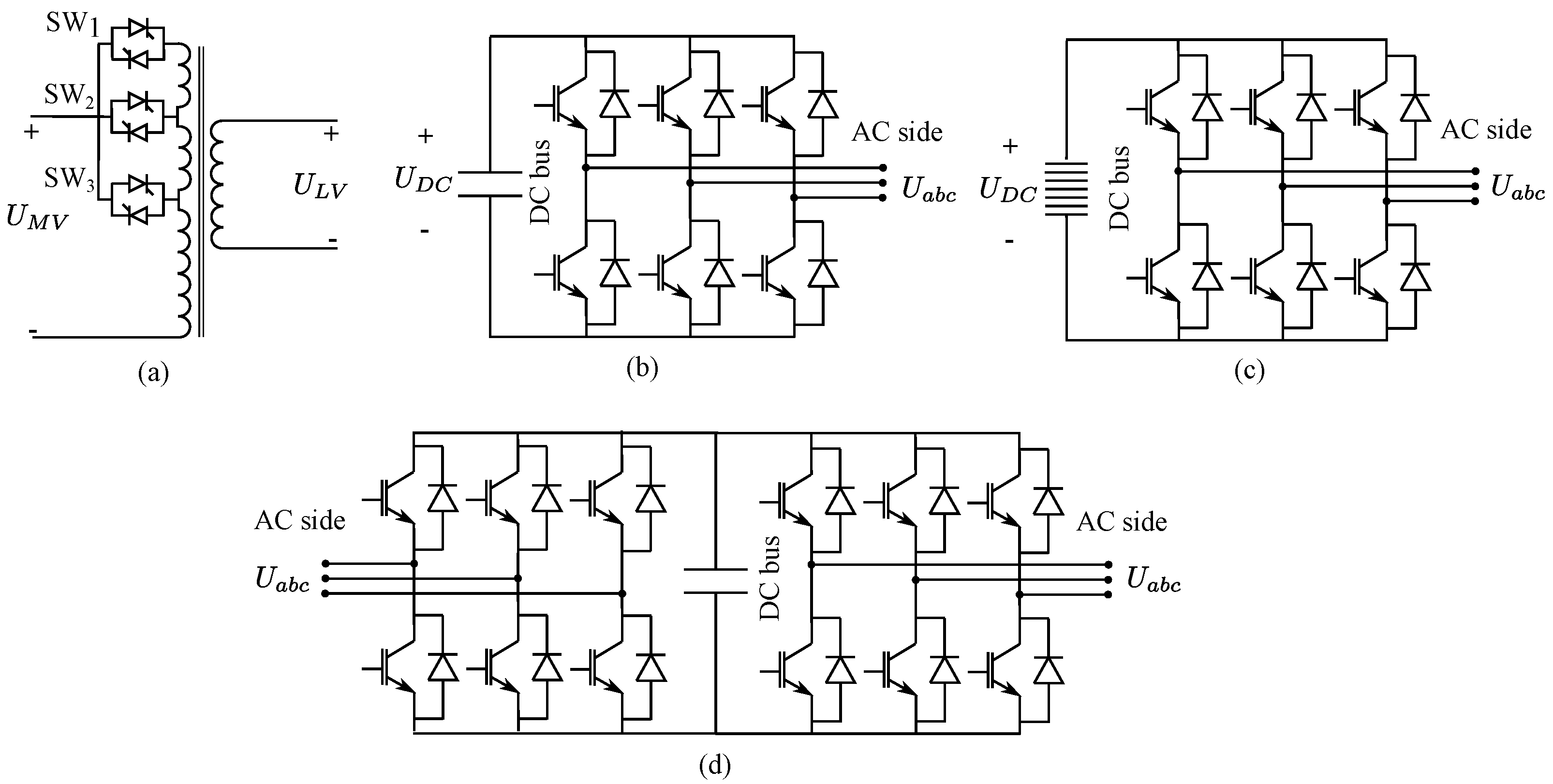
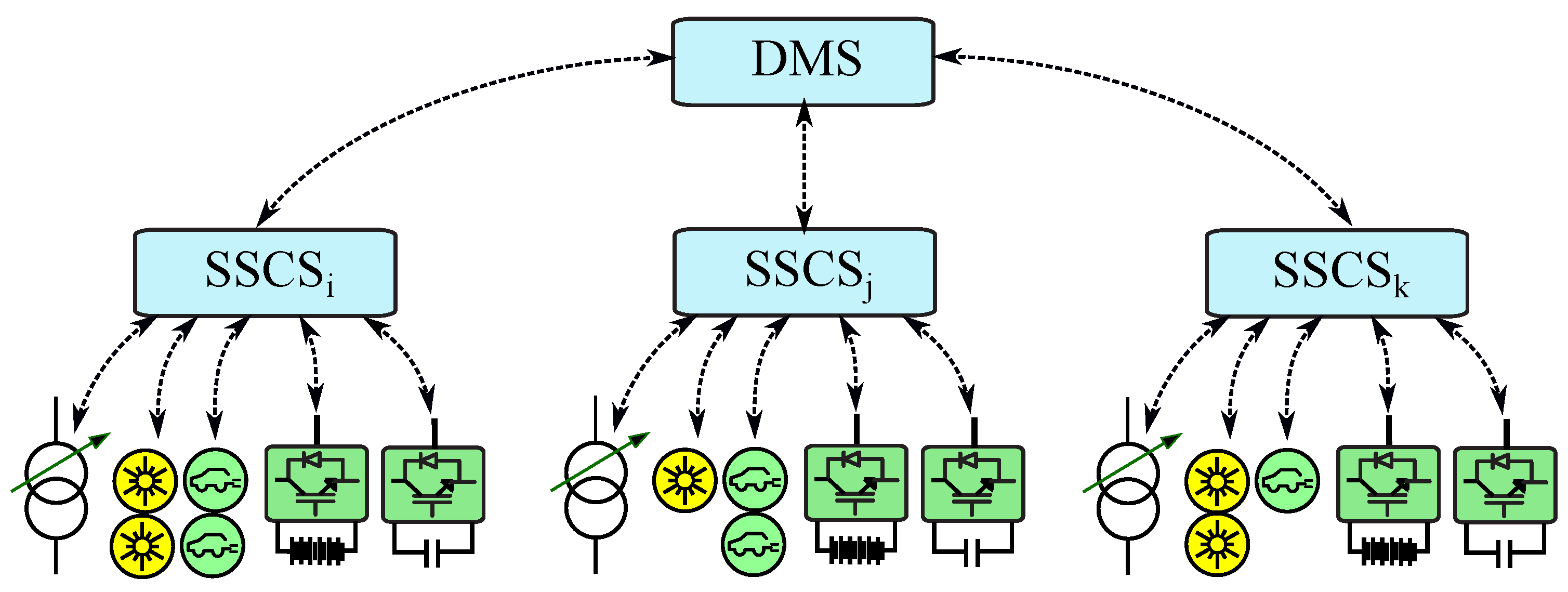
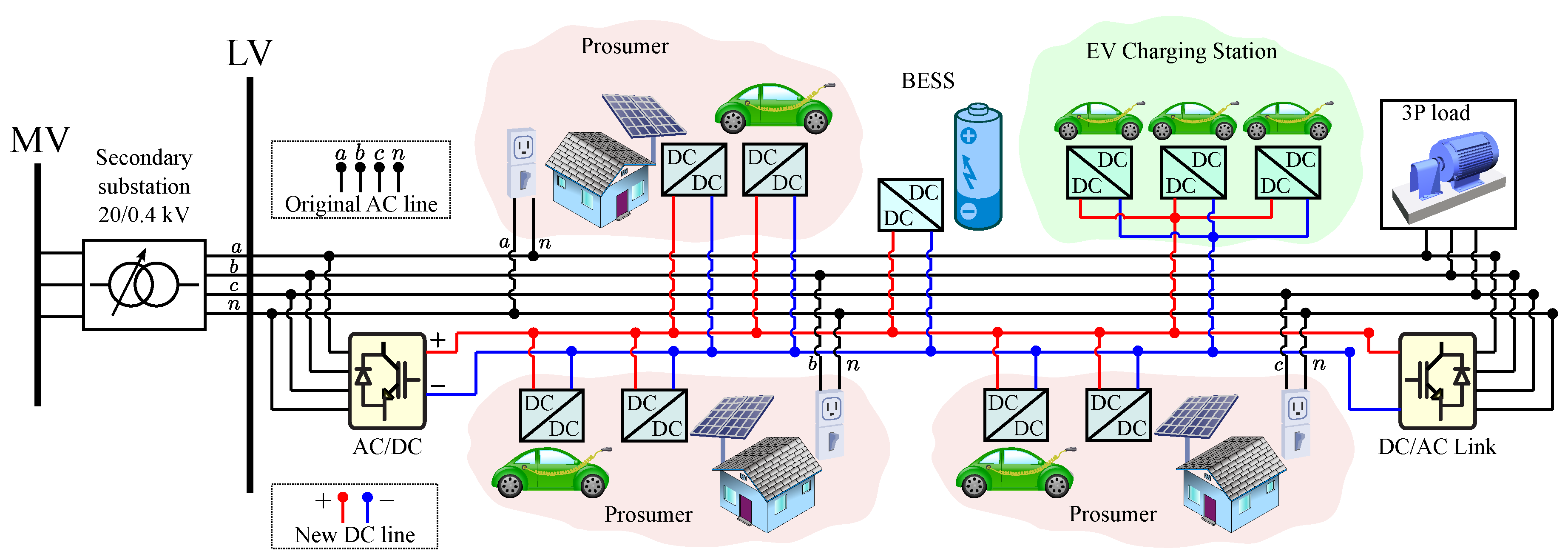

| Ancillary Service | Nature | Dynamic Charac. | AC Side | DC Side |
|---|---|---|---|---|
| Voltage control | Voltage control | Dynamic | ✓ | ✓ |
| Congestion release | Congestion release | Quasi steady-state | ✓ | ✓ |
| Unbalance reduction | Power quality issue | Quasi steady-state | ✓ | |
| Harmonic distortion mitigation | Power quality issue | Quasi steady-state | ✓ | ✓ |
| Power smoothing | Power quality issue | Dynamic | ✓ | ✓ |
| Inertial response | Frequency control | Dynamic | ✓ | |
| Power frequency response | Frequency control | Dynamic | ✓ |
© 2019 by the authors. Licensee MDPI, Basel, Switzerland. This article is an open access article distributed under the terms and conditions of the Creative Commons Attribution (CC BY) license (http://creativecommons.org/licenses/by/4.0/).
Share and Cite
Maza-Ortega, J.M.; Mauricio, J.M.; Barragán-Villarejo, M.; Demoulias, C.; Gómez-Expósito, A. Ancillary Services in Hybrid AC/DC Low Voltage Distribution Networks. Energies 2019, 12, 3591. https://doi.org/10.3390/en12193591
Maza-Ortega JM, Mauricio JM, Barragán-Villarejo M, Demoulias C, Gómez-Expósito A. Ancillary Services in Hybrid AC/DC Low Voltage Distribution Networks. Energies. 2019; 12(19):3591. https://doi.org/10.3390/en12193591
Chicago/Turabian StyleMaza-Ortega, José M., Juan M. Mauricio, Manuel Barragán-Villarejo, Charis Demoulias, and Antonio Gómez-Expósito. 2019. "Ancillary Services in Hybrid AC/DC Low Voltage Distribution Networks" Energies 12, no. 19: 3591. https://doi.org/10.3390/en12193591
APA StyleMaza-Ortega, J. M., Mauricio, J. M., Barragán-Villarejo, M., Demoulias, C., & Gómez-Expósito, A. (2019). Ancillary Services in Hybrid AC/DC Low Voltage Distribution Networks. Energies, 12(19), 3591. https://doi.org/10.3390/en12193591





